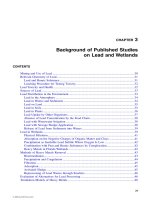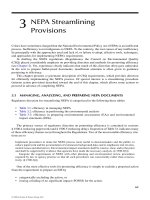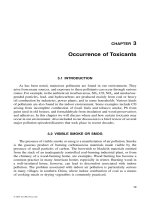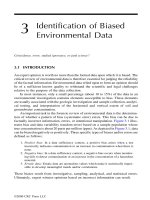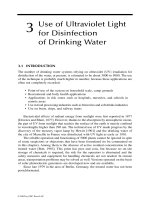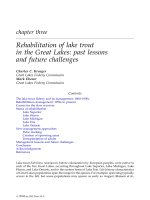INTERFACIAL APPLICATIONS IN ENVIRONMENTAL ENGINEERING - CHAPTER 3 doc
Bạn đang xem bản rút gọn của tài liệu. Xem và tải ngay bản đầy đủ của tài liệu tại đây (160.82 KB, 16 trang )
3
Comparison of Catalytic Reduction of
NO by Propene on Zeolite-Based and
Clay-Based Catalysts Ion-Exchanged
by Cu
JOSE L. VALVERDE, FERNANDO DORADO, PAULA SA
´
NCHEZ,
ISAAC ASENCIO, and AMAYA ROMERO University of Castilla–La
Mancha, Ciudad Real, Spain
I. INTRODUCTION
Selective catalytic reduction (SCR) of NO with hydrocarbons has been a subject
of extensive study due to its potential for the effective control of NO emission
in oxidant environments [1–11]. Hydrocarbons would be the preferred reducing
agents over NH
3
because the practical problems associated with its use: handling
and slippage through the reactor. Although many types of catalysts have been
studied for this purpose, only a few copper-loaded zeolites have been demon-
strated as adequate, and among them Cu-ZSM-5 gives good yields and seems to
be one of the most active ones [3,5,12–15]. The majority of these catalysts are
ion-exchanged zeolites, including H
ϩ
forms. Metal oxides supported on alumina
have also been studied. Shimuzu et al. [16,17] recently reported that Cu-aluminate
catalysts, containing highly dispersed Cu
2ϩ
ions in the aluminate phase, showed
high de-NOx activity comparable to Cu-ZSM-5 and higher hydrothermal stabil-
ity. The activity of copper-loaded zeolites was found to depend on the Cu content.
Iwamoto et al. [18] observed that the activity of Cu-ZSM-5 increased with the
increment of the Cu exchange level. On the other hand, the concentration of O
2
in the NO-containing stream plays an important role in the reaction rate and
product selectivity of the SCR reaction. It has been suggested that the roles of
the O
2
in this reaction are: to activate NO and hydrocarbons [19], to oxidize NO
to NO
2
[20], to maintain a Cu
ϩ
/Cu
2ϩ
site balance [21], and to react with carbona-
ceous deposits on Cu-ZSM-5 [20,22].
TM
Copyright n 2003 by Marcel Dekker, Inc. All Rights Reserved.
40 Valverde et al.
The majority of Cu ions in copper-exchanged zeolites are found as single
cations located in structural cationic sites. Besides these atomically dispersed
single Cu ions in cationic sites, dispersed CuO species were also detected [23–
25]. In any case, the facile reduction from Cu
2ϩ
to Cu
ϩ
suggested that a possible
redox mechanism could be involved. Shpiro et al. [26] suggested that copper in
overexchanged Cu-ZSM-5 zeolites exists as small clusters of Cu-O or as isolated
ions whose oxidation state (Cu
2ϩ
or Cu
ϩ
) depends on the atmosphere present.
Corma et al. [27/38] observed that the most active Cu-beta zeolites for SCR of
NOx were those in which the conversion between Cu
2ϩ
and Cu
ϩ
was quickly
produced under reaction conditions. This conversion was easier in overexchanged
Cu-beta samples.
Pillared clays (PILCs) are two-dimensional materials prepared by exchanging
charge-compensating cations between the clay layers with large inorganic metal
hydroxycations that are oligomeric and are formed by hydrolysis of metal oxides
or salts. After calcination, the metal hydroxycations are decomposed into oxide
pillars that keep the clay layers apart and create interlayer and interpillar spaces,
thereby exposing the internal surfaces of the clay layers. The size of these oligo-
mers appears to control the size of the pore opening in the pillared clays. It is
known that the basal spacing of the natural clay is 9.6 A
˚
and that the insertion
of these hydroxycations increases it to 18–20 A
˚
. In principle, any metal oxide
or salt forming polynuclear species upon hydrolysis can be inserted as a pillar.
Intercalated clays are usually natural smectites clays. Properties such as acidity,
surface area, pore size distribution, and both thermal and hydrothermal stability
depend on the method of synthesis as well as on the nature of the host clay. Most
common ions used as pillaring agents prepared by hydrolysis of the correspond-
ing salts in solution are polycationic species of Al, Zr, Fe, Cr, etc. Can
˜
izares et
al. [28] recently reported a comparative study in which different PILCs with
single-oxide pillers of Fe, Cr, and Zr and mixed-oxide pillars of these metals and
Al were prepared from two different bentonites.
One of the fields of applications of pillared clays is catalysis. More specifi-
cally, PILC-based catalysts were found to be useful for the SCR reaction by NH
3
and hydrocarbons [29–31]. Using hydrocarbons, Cu-ion exchanged PILC yielded
higher than those of Cu-ZSM-5-based catalysts; and their activity was only
slightly decreased by H
2
O and SO
2
[32,33]. In an earlier paper, Yang et al. [34]
tested different ion-exchanged pillared clays as catalysts for selective catalytic
reduction of NO by ethylene. Cu-Ti-PILCs showed the highest activities at tem-
peratures below 643 K, whereas Cu-Al-PILC was the most active at temperatures
above 673 K. Ti-PILC was obtained using a procedure in which the pillaring
solution of partially hydrolyzed Ti-polycations was prepared by first adding TiCl
4
into a HCl solution.
In spite of these relevant results, Ti-PILCs have received considerably less
attention than other pillared clays. As a result, few preparation methods for these
TM
Copyright n 2003 by Marcel Dekker, Inc. All Rights Reserved.
SCR of NO on Zeolite vs. Clay Catalysts 41
materials have been reported [34,35]. In our case, Ti metoxide was used as the
source of Ti in the preparation of Ti-PILCs.
The aims of this work are:
1. To compare the catalytic reduction of NO by propene on ZSM-5 based and
Ti-PILC-based catalysts ion-exchanged by Cu.
2. To characterize all the catalysts here prepared in order to relate physical and
chemical properties to the catalytic behavior of the two sets of catalysts.
II. EXPERIMENTAL
A. Preparation of Catalysts
NaZSM-5 zeolite (Si/Al ratio of 20) was synthesized according to the method
described elsewhere [36] using ethanol as the template. X-ray diffraction (XRD)
confirmed that the product was 100% crystalline [37]. Cu was introduced by
conventional ion exchange, using 25 mL of 0.1 M Cu(CH
3
COO)
2
⋅4H
2
O aqueous
solutions per gram of zeolite. The mixture was kept under agitation at the desired
ion exchange temperature (303, 328, or 353K) for 14 h. Next, the suspension
was filtered and thoroughly washed with deionized water in order to completely
remove the occluded salt, and the solid was then air-dried at 393 K for 14 h. The
whole procedure was repeated twice for some catalysts. Finally, the samples were
calcined in air at 823 K for 4 h. Table 1 summarizes the zeolite-based catalysts
here prepared. These catalysts were referred to as a function of the copper load-
ing. For instance, CuZ-2.9 corresponds to a Cu-ZSM5 with a copper content of
2.9% by weight.
Ti-PILC was prepared as follows. The starting clay was a purified montmoril-
lonite (purified-grade bentonite power from Fisher Company), which has a parti-
clesizeof2µm or less, a cation exchange capacity (CEC) of 97 eq/kg dry clay
and a surface area of 44.7 m
2
/g. The pillaring solution of partially hydrolyzed
Ti-polycations was prepared by first adding titanium metoxide to a 5 M HCl
solution. The solution was aged for 3 h at room temperature. Then 1 gram of
starting clay was dispersed in 1 L of deionized water for 3 h under stirring. The
pillaring solution was slowly added with vigorous stirring into the clay suspen-
sion until the amount of pillaring solution reached that required to obtain a Ti/
Clay ratio of 15 mM of Ti/g clay. The intercalation step took about 16 h. Subse-
quently, the mixture was separated by vacuum filtration or centrifugation and
washed with deionized water until the liquid phase was chloride free. The sample
was dried at 393 K for 12 h and calcined at 773 K for 2 h. The basal spacing
of the resulting sample, measured by XRD, was 23 A
˚
.
One gram of the Ti-pillared bentonite was added to 200 mL of 0.05 M copper
acetate solution. The mixture was stirred for 6 h at room temperature. The ion
TM
Copyright n 2003 by Marcel Dekker, Inc. All Rights Reserved.
42 Valverde et al.
TABLE 1 Composition and Characterization of Zeolite-Based Catalysts
a
Ion exchange steps Cu Weak acid site Strong acid site
and temperature content Ion exchange density density Surface area Micropore area Micropore
Catalyst (K) (wt %) level (%) (mmol NH
3
/g) (mmol NH
3
/g) (m
2
/g) (m
2
/g) volume (m
3
/g)
NaZSM-5 — 0 0 0.950 (579 K) Not detected 369.3 (100%) 360.0 (100%) 0.158 (100%)
CuZ-2.4 1—303 2.4 94 0.881 (565 K) Not detected 345.4 (94%) 338.8 (94%) 0.140 (89%)
CuZ-2.6 1—328 2.6 103 0.822 (573 K) Not detected — — —
CuZ-2.9 2—303 2.9 116 0.907 (555 K) Not detected 326.4 (88%) 309.6 (86%) 0.130 (82%)
CuZ-3.7 2—328 3.7 148 0.781 (573 K) Not detected — — —
CuZ-4.4 1—353 4.4 175 0.477 (581 K) 0.440 (911 K) 321.0 (83%) 298.7 (83%) 0.126 (79%)
a
Temperatures corresponding to the maximum of the desorption peak are included in parentheses together with the acid sites density value.
TM
Copyright n 2003 by Marcel Dekker, Inc. All Rights Reserved.
TM
Copyright n 2003 by Marcel Dekker, Inc. All Rights Reserved.
SCR of NO on Zeolite vs. Clay Catalysts 43
exchange product was collected by filtration or centrifugation, followed by wash-
ing five times with deionized water. The obtained solid sample was first dried
at 393 K in air for 12 h and then calcined at 773 K for 2 h. After this pretreatment,
the sample was ready for further experiments. Table 2 summarizes the PILC-
based catalysts here prepared. Pillared clay-based catalysts were referred to as a
function of the copper loading. For instance, CuTi-7.4 corresponds to a Cu-Ti-
PILC with a copper content of 7.4% by weight.
B. Characterization Methods
X-ray diffraction (XRD) patterns were measured with a Philips model PW 1710
diffractometer using Ni-filtered CuKα radiation. To summarize the (001) reflec-
tion intensity in PILC samples, oriented clay-aggregate specimens were prepared
by drying clay suspensions on a glass slide.
Surface area and pore size distributions were determined by using nitrogen
as the sorbate at 77 K in a static volumetric apparatus by using a micromeritics
ASAP 2010 sorptometer. For this analysis, samples were outgassed at 453 K for
16 h under a vacuum of 5 ϫ 10
Ϫ6
torr. Specific total surface areas were calculated
by using the Brunauer, Emmett, and Teller (BET) equation. The Horvath–
Kawazoe method was used to determine microporous surface area and volume.
Total acid site density of the samples was measured by a temperature pro-
grammed desorption (TPD) of ammonia, by using a Micromeritics TPD-TPR
analyzer. Samples were housed in a quartz tubular reactor and pretreated in flow-
ing helium (99.999%) while heating at 15 K min
Ϫ1
up to 773 K. After 0.5 H at
773 K, the samples were cooled to 453 K and saturated for 0.25 h in an ammonia
(99.999%) stream. The sample was then allowed to equilibrate in a helium flow
at 453 K for 1 h. Finally, ammonia was desorbed using a linear heating rate of
15 K min
Ϫ1
. Temperature and detector signals were simultaneously recorded. The
average relative error in the acidity determination was lower than 3%.
Temperature programmed reduction (TPR) measurements were carried out
with the same apparatus previously described. After loading, the sample was
outgassed by heating at 20 K min
Ϫ1
in an argon flow to 773 K. This temperature
was constant for 30 min. Next, it was cooled to 298 K and stabilized under an
argon/hydrogen (99.999%, 83/17 volumetric ratio) flow. The temperature and
detector signals were continuously recorded while heating at 20 K min
Ϫ1
. A cool-
ing trap placed between the sample and the detector retained the liquids formed
during the reduction process. The TPR profiles were reproducible with an average
relative error in the determination of the reduction maximum temperatures lower
than 2%.
The metallic content (wt%) was determined by atomic absorption measure-
ments by using a SpectrAA 220 FS analyzer. In all cases, calibrations from the
corresponding patron solutions were performed.
TM
Copyright n 2003 by Marcel Dekker, Inc. All Rights Reserved.
44 Valverde et al.
TABLE 2 Composition and Characterization of PILC-Based Catalysts
a
Weak acid site
Cu content Ion exchange level density Strong acid site Surface area Micropore area Micropore
Catalyst (wt%) (%) (mmol NH
3
/g) density (mmol NH
3
/g) (m
2
/g) (m
2
/g) volume (m
3
/g)
Ti-PILC 0 0 0.437 (579 K) 0.092 (691 K) 273.2 (100%) 224.5 (100%) 0.181 (100%)
CuTi-4.6 4.6 149 0.108 (548 K) 0.362 (628 K) 241.7 (88%) 202.2 (90%) 0.153 (85%)
CuTi-7.4 7.4 240 0.136 (543 K) 0.594 (623 K) 234.3 (86%) 189.1 (84%) 0.143 (79%)
CuTi-9.0 9.0 292 0.156 (533 K) 0.738 (613 K) 201.8 (74%) 153.7 (68%) 0.126 (69%)
a
Temperatures corresponding to the maximum of the desorption peak are included in parentheses together with the acid sites density value.
TM
Copyright n 2003 by Marcel Dekker, Inc. All Rights Reserved.
TM
Copyright n 2003 by Marcel Dekker, Inc. All Rights Reserved.
SCR of NO on Zeolite vs. Clay Catalysts 45
C. Reaction Studies
The catalytic tests were carried out in a fixed-bed flow reactor. The standard
reactant mixture was one constituted by NO (1000 ppm), C
3
H
6
(1000 ppm), O
2
(5%), and balance He at ambient pressure. The flow rates were controlled by
calibrated Brooks flowmeters. The total flow rate was 125 mL/min. The space
velocity of the feed was 15,000 h
Ϫ1
(GHSV). The effluent stream was analyzed
by a chemiluminescent NO/NOx analyzer (ECO PHYSICS NO-NO
2
-NOx ana-
lyzer).
III. RESULTS
A. Characterization of the Catalysts
Tables 1 and 2 list, for all the catalysts, the specific surface area, micropore area,
and micropore volume, the weak and strong acid site density, and the copper
content. The same tables also summarize the Cu ion exchange levels that were
determined taking as a reference, in the case of zeolite-based catalysts, the num-
ber of aluminum atoms contained in the structure and, in the case of PILC-based
catalysts, the cation exchange capacity (CEC) of the clay [34]. It can be observed
that, except for the CuZ-2.4 sample, all the catalysts presented more Cu content
than that corresponding to 100% ion exchange. In fact, all the zeolite-based cata-
lysts contained sodium ions. As expected, the loading of these decreased with
increasing copper content in zeolite (0.16 wt% of Na for the CuZ-2.4 sample
and 0.07 wt% of Na for the CuZ-4.4 sample. It is also observed for these catalysts
that for the same number of ion exchange steps the copper loading increased
with increasing ion exchange temperatures and the acid site density progressively
diminished from the value corresponding to the parent Na/ZSM5 (0.95 mmol
NH
3
/g) to 0.822 and 0.907 mmol NH
3
/g in the ZCu-2.6 and ZCu3.7 samples,
respectively. In this case, it is clear that acidity is a combination of two effects:
the presence of Cu and Na on the catalyst. The first Cu ions incorporated to
zeolites would occupy hidden sites (small zeolite cages) [38]. These sites may
not be very accessible to NH
3
molecules. Since multiple ion exchange steps are
needed to achieve the complete filling of small cages, the increase of copper
content would lead Cu species to incorporate at more accessible positions. As a
consequence the acidity increases. Strong acid site density was observed only
for zeolite-based catalysts with copper content higher than 4.4% by weight. In
contrast, all the PILC-based catalysts presented strong acid sites.
An increase of Cu content was accompanied in both sets of catalysts by a
decrease of BET surface area and micropore volume, indicating that Cu intro-
duced into the pillared matrix would preferentially occupy the interlayer area
[39], whereas the Cu present in zeolite would cause the partial blocking of the
TM
Copyright n 2003 by Marcel Dekker, Inc. All Rights Reserved.
46 Valverde et al.
zeolite channels. Temperature-programmed reduction can be used to identify and
quantify the copper species in ion-exchanged samples. According to Delahay et
al. [40] the reactions involved in the copper reduction process are:
CuO ϩ H
2
→ Cu
0
ϩ H
2
O
Cu
2ϩ
ϩ
1
2
H
2
→ Cu
ϩ
ϩ H
ϩ
Cu
ϩ
ϩ
1
2
H
2
→ Cu
0
ϩ H
ϩ
Some authors showed that, depending on the copper content, the reduction of
Cu
2ϩ
to Cu
ϩ
would occur at lower temperatures while the reduction of Cu
ϩ
to
Cu
0
would occur at higher temperatures [41–43]. When the copper content in
the sample is higher, the excess copper may be found as oxygenated clusters
more easily reduced than the isolated copper species [24,34].
As shown in Table 3, low H
2
consumption was found in all the samples, indi-
cating that Cu species are hard to reduce to lower valence. In the case of zeolite-
based catalysts, this fact is justified considering the existence of metal ions in
small zeolite cages [38]. In these small cages, Cu
2ϩ
ions would be favorably
coordinated to the framework oxygens. This bonding is generally much stronger
for multivalent than for monovalents ions. Each ion would not be readily accessi-
ble for H
2
molecules, and the activation energy for reducing such isolated metal
ions would be rather high. These results are in good agreement with the measure-
ments of acidity mentioned earlier. In PILC-based catalysts, the H
2
/Cu is slightly
TABLE 3 Ratios of H
2
Consumption to Cu (H
2
/Cu, mol/mol, Measured by TPR
Experiments) of Zeolite-and PILC-Based Catalysts
a
H
2
/Cu (mol/mol) H
2
/Cu (mol/mol) H
2
/Cu (mol/mol) H
2
/Cu (mol/mol)
Catalyst CuO to Cu
0
Cu
2ϩ
to Cu
ϩ
Cu
ϩ
to Cu
0
Total
NaZSM-5 — — — —
CuZ-2.4 Not detected 0.169 (517 K) 0.322 (643 K) 0.491
CuZ-2.6 Not detected 0.181 (503 K) 0.271 (676 K) 0.452
CuZ-2.9 Not detected 0.249 (503 K) 0.204 (693 K) 0.453
CuZ-3.7 Not detected 0.177 (450 K) 0.260 (653 K) 0.437
CuZ-4.4 0.251 (450 K) 0.134 (461 K) 0.216 (663 K) 0.601
Ti-PILC — — — —
CuTi-4.6 0.405 (473 K) 0.172 (543 K) 0.046 (663 K) 0.623
CuTi-7.4 0.321 (431 K) 0.170 (507 K) 0.051 (685 K) 0.542
CuTi-9.0 0.395 (426 K) 0.107 (510 K) 0.036 (693 K) 0.538
a
Temperatures corresponding to the maximum of the reduction peak are included in parentheses.
TM
Copyright n 2003 by Marcel Dekker, Inc. All Rights Reserved.
SCR of NO on Zeolite vs. Clay Catalysts 47
higher than that of the zeolite, also showing that in these samples an important
part of Cu species is not accessible for H
2
molecules.
For the zeolite-based catalysts with a copper content lower than 4.4 wt%, the
TPR profiles showed two reduction peaks (Table 3) which suggests a two-step
reduction process of isolated Cu
2ϩ
species. The peak at a lower temperature would
indicate that the process of Cu
2ϩ
to Cu
ϩ
occurred. The other peak at a higher
temperature suggests that the produced Cu
ϩ
was further reduced to Cu
0
. For the
sample CuZ-4.4, a peak existing at 450 K would be related to the presence of
CuO aggregates. Due to the absence of a diffraction line of CuO species in XRD
patterns of this sample, the occurrence of CuO aggregates larger than 3 mm can
be ruled out [40]. According to the measurements of acidity, the presence of CuO
aggregates would be related to the occurrence of strong acid sites. On the other
hand, there is a clear shift to lower temperatures of the second peak (Cu
2ϩ
to Cu
ϩ
)
that showed that Cu
ϩ
becomes more difficult to reduce as Cu content decreases.
In the case of PILC-based catalysts, the peaks corresponding to the three reac-
tions involved in the copper reduction are present. Again, there is a clear shift
to a lower temperature of the second peak (Cu
2ϩ
to Cu
ϩ
) and the first (CuO to
Cu
0
) that showed that Cu
2ϩ
and CuO get easier to reduce as Cu content increases.
This fact would indicate that the higher the Cu content is, the lower CuO species
dispersion that is observed. In a similar way as observed in zeolite-based cata-
lysts, no diffraction of CuO species in XRD were detected. Figure 1 compares
the TPR-profiles of the CuZ-2.9 and CuTi-7.4 samples.
Figure 2 shows, for all the catalysts, the H
2
consumption for the Cu
2ϩ
to Cu
ϩ
process as a function of the Cu loading. With an increase in Cu content, H
2
consumption increased, passing through a maximum, and then decreased at
higher loadings. It can be verified that the maximum in the case of zeolite-based
catalysts corresponds to the CuZ-2.9 sample and in the case of PILC-based cata-
lysts to the CuTi-7.4 sample.
B. NOx Reduction Activity
The catalytic performance of the catalysts for the SCR reaction of NOx with
propene as a function of the reaction temperature is summarized in Table 4. The
presence of copper in the catalysts enhanced the catalytic activity. With an in-
crease in reaction temperature, NOx conversion increased, passing through a
maximum, and then decreased at higher temperatures. According to Yang et al.
[34], the decrease in NOx conversion at higher temperatures was due to the com-
bustion of propene. In general, all the Cu-zeolites samples presented the maxi-
mum NOx conversion at the same temperature (623 K). Similar observations can
be derived for all PILC-based catalysts, but in this case the corresponding maxi-
mum appeared at 523 K. It can be observed that increasing the copper loading
increased NOx conversion until the copper loading reached 116% ion exchange
TM
Copyright n 2003 by Marcel Dekker, Inc. All Rights Reserved.
48 Valverde et al.
FIG. 1 TPR profiles of CuTi-7.4 and CuZ-2.9.
FIG. 2 Hydrogen consumption for the Cu
2ϩ
to Cu
ϩ
reduction processes as a function
of Cu loading.
TM
Copyright n 2003 by Marcel Dekker, Inc. All Rights Reserved.
SCR of NO on Zeolite vs. Clay Catalysts 49
TABLE 4 Catalytic Performance of Zeolite- and
PILC-Based Catalysts Ion Exchanged by Cu
Temperature for
Maximum maximum NOx
Catalyst NOx conversion conversion (K)
CuZ-2.4 56.9 623
CuZ-2.6 62.4 623
CuZ-2.9 65.7 623
CuZ-3.7 65.6 623
CuZ-4.4 56.4 623
CuTi-4.6 26.4 523
CuTi-7.4 59.3 523
CuTi-9.0 36.7 523
Reaction conditions: [NO] ϭ [C
3
H
6
] ϭ 1000 ppm, [O
2
] ϭ 5%,
[He] ϭ balance; GHSV ϭ 15,000 h
Ϫ1
.
FIG. 3 Conversion of NOx for the SCR reaction on CuTi-7.4 and CuZ-2.9. Reaction
conditions: [NO] ϭ [C
3
H
6
] ϭ 1000 ppm, [O
2
] ϭ 5%, [He] ϭ balance, GHSV ϭ 15,000
h
Ϫ1
.
TM
Copyright n 2003 by Marcel Dekker, Inc. All Rights Reserved.
50 Valverde et al.
in zeolite-based catalysts, CuZ-2.9 sample, and 240% ion exchange in PILC-
based catalysts, CuTi-7.4 sample (Fig. 3). Both CuZ-2.9 and CuTi-7.4 showed
the highest H
2
consumption for the Cu
2ϩ
to Cu
ϩ
process, taking as a reference
the sets of zeolite-based and PILC-based catalysts, respectively. Further increase
in the copper loading resulted in a decrease in NOx conversion.
IV. DISCUSSION
In this work the parent ZSM-5 was in the sodium form. According to Torre-
Abreu et al. [15], Cu-MOR catalysts prepared from the sodium form exhibited
much higher activity than those prepared from the acid form. Their results showed
that Bro
¨
nsted acidity does not promote the NO selective reduction by propene.
On the other hand, Bula
´
nek et al. [43] observed that the copper present in zeolite
together with a sodium cation was more easily reduced than in CuH-zeolites. H
2
TPR results showed that the copper in zeolite-based catalysts was present mainly
in the form of isolated Cu
2ϩ
ions. Cu
2ϩ
ions could be partially reduced to Cu
ϩ
ions when the samples were treated at high temperatures. Apart from these ions,
in PILC-based catalysts, CuO aggregates were also detected. As already men-
tioned, Cu
2ϩ
ions play an important role in the SCR reaction of NOx by hydrocar-
bons. In the presence of propene, the Cu
2ϩ
is reduced to Cu
ϩ
, and then Cu
ϩ
would
be oxidized back to Cu
2ϩ
by NOx, thus completing the catalytic cycle [40,44].
In a study reported by Attfield et al. [45] for Cu-mordenite materials, it was
observed that the low coordination of the Cu
2ϩ
cations made them much more
susceptible to redox chemistry when exposed to NO than a more highly coordi-
nated Cu
2ϩ
cation. Similar reasoning was extended to other extremely active de-
NOx zeolite catalysts, like ZSM-5 [45]. This pentasil zeolite has few cation sites
within small inaccessible cavities in this structure, and so it will render most
of the extra-framework transition metal cations poorly coordinated and highly
accessible to reactant molecules. According to Bula
´
nek et al. [43], Cu ions in
zeolite matrices of MFI, FER, and MOR structures revealed two most populated
Cu ions types, denoted as the Cu-II and Cu-IV types of ions (46). The Cu-II type
of ions exhibited pyramidal coordination and high positive charge and are bal-
anced by two negative framework charges, two AlO
2
Ϫ
. The Cu-IV type of ions
were ascribed to the Cu ions with close-up-to planar coordination and low posi-
tive charge and are adjacent to single AlO
2
Ϫ
anions. At low Cu loadings and a
high concentration of aluminum in the framework, the Cu-II type of ions prevails,
while at high Cu loadings and a low concentration of aluminum in the framework,
the Cu-IV type of ions become predominant.
The major species present in pillared montmorillonite exchanged with copper
at low pH are physisorbed square planar tetra-aquo-complexes [Cu(H
2
O)
4
]
2ϩ
[47]. Calcination of the samples at 673 K produced a significant change in the
Cu
2ϩ
ion environment. According to Bahranowski et al. [47], the most character-
istic feature was the increase in covalency of the Cu-O in-plane σ-bonding due
TM
Copyright n 2003 by Marcel Dekker, Inc. All Rights Reserved.
SCR of NO on Zeolite vs. Clay Catalysts 51
to the dehydration/dehydroxilation processes accompanying high-temperature
treatment, resulting in the attachment of copper centers to the lattice oxygens,
forming links with the pillar rather than with the silicate sheet. It was suggested
that in catalytic reactions proceeding according to the redox mechanism, the in-
plane bridging oxygens played an important role in electron transfer from the
electron-accepting to the electron-donating sites at the catalytic surface. Ac-
cording to Bahranowski et al. [48], single doping of Al-PILC with copper intro-
duced approximately 40% more than the CEC of the Al-PILC samples, sug-
gesting an adsorption mechanism involving the formation of a complex between
copper ions and surface pillars rather than a simple ion exchange. Based on EPR
studies, it was found that the majority of copper ions were associated with alumi-
num pillars as isolated Cu
2ϩ
ions, the rest forming clusters at an undefined loca-
tion. Each subsequent doping increased the relative content of copper clusters
[49]. A model of the calcined Cu-Al-PILC-based catalysts for oxidation of tolu-
ene and xylene with hydroperoxide was presented by Bahranowski et al. [39].
Thus, three types of copper species were proposed: isolated Cu ions anchored at
the pillars rather than at the surface of the silica layer, Cu
2ϩ
clusters as patches
of amorphous CuO, and cupric oxide. The presence of Cu
2ϩ
clusters increased
with the copper loading on the catalysts. Because isolated Cu ions and Cu
2ϩ
clusters must be located in the interlayer, an increase in Cu content resulted in
a reduction of pore volume due to the filling of the interlayer.
According to these studies, it seems clear that the Cu-IV type of ions, more
poorly coordinated but highly accessible and reducible than the Cu-II type of
ions, have to be the active sites for NO decomposition to N
2
. As expected, the
higher the content of these species on the catalysts is, the higher the catalytic
activity that is observed (Table 4 and Fig. 2). The same maximum of temperature
found in each set of catalysts (623 K for zeolite-based catalysts and 523 K for
PILC-based catalysts) would indicate that there is no change in the mechanism
of reaction when passing in a certain set of catalysts from one sample to another.
Anyway, PILC-based catalysts appear to be more active catalytically than zeolite-
based catalysts: The former required a lower reaction temperature to get the maxi-
mum of NOx conversion than did the latter. According to Yang et al. [34], Cu
2ϩ
on the pillared clay is more active than that on ZSM-5 due to the fact that the
redox cycle occurs more easily on the pillared catalysts. On the other hand, it is
also observed that the increase in Cu loading in the PILC-based catalysts resulted
in an increase in CuO aggregates (Table 3). In a study of the reducibility and
catalytic activity in propane oxidation [43], it was observed that the presence of
disperse undefined CuO species in Cu-MFI-based catalysts resulted in a substan-
tial increase in propane conversion as well selectivity to CO
2
. This fact would
explain the decided decrease in NO conversion with increasing copper content
in the CuTi-7.4 sample observed at reaction temperatures higher than that corre-
sponding to the maximum of conversion. This decided decrease was not observed
in the CuZ-2.9 sample, with no occurrence of CuO species (Fig. 3).
TM
Copyright n 2003 by Marcel Dekker, Inc. All Rights Reserved.
52 Valverde et al.
Finally, it can be noted that the CuTi-7.4 sample, the most active catalyst found
here, presented at 240% ion exchange. This value was similar to that reported by
Yang et al. [34] for the most active Cu-Ti-PILC for SCR of NO by ethylene. In
this case the best catalyst presented a 245% ion exchange.
IV. CONCLUSIONS
Selective catalytic reduction of NO by propene was investigated on copper ion–
exchanged ZSM-5 and Ti-PILC in the presence of excess oxygen. H
2
TPR results
showed that the copper in zeolite-based catalysts was present mainly in the form
of isolated Cu
2ϩ
ions that could be partially reduced to Cu
ϩ
ions when the samples
were treated at high temperatures. Apart from these ions, in PILC-based catalysts,
CuO aggregates were also detected. The presence of copper in the catalysts en-
hanced the catalytic activity. With the increase in reaction temperature, NOx
conversion increased, passing through a maximum, and then decreased at higher
temperatures. In the presence of propene, the Cu
2ϩ
should be reduced to Cu
ϩ
,
and then Cu
ϩ
would be oxidized back to Cu
2ϩ
by NOx, thus completing the
catalytic cycle. In general, all the Cu-zeolite samples present the maximum NOx
conversion at the same temperature (623 K). Similar observations for all PILC-
based catalysts can be derived, but in this case the corresponding maximum ap-
peared at 523 K. It was observed that increasing the copper loading increased
NOx conversion until the copper loading reached 116% ion exchange in the zeo-
lite-based catalysts, the CuZ-2.9 sample, and 240% ion exchange in PILC-based
catalysts, the CuTi-7.4 sample. It seems clear that the Cu
2ϩ
, poorly coordinated
but highly accessible and reducible, have to be the active sites for NO decomposi-
tion to N
2
. As expected, the higher the content of these species on the catalysts
is, the higher the catalytic activity that is observed. PILC-based catalysts appeared
to be more active catalytically than zeolite-based catalysts: The former required
a lower reaction temperature to get the maximum NOx conversion than did the
latter. Cu
2ϩ
on the pillared clay would be more active than that on ZSM-5 due
to the fact that the redox cycle occurs more easily on the pillared catalysts.
ACKNOWLEDGMENTS
Financial support from the European Commission (Contract ERK5-CT-1999-
00001) and DGICYT (Direccio
´
n General de Investigacio
´
n Cientı
´
fica y Te
´
cnica,
Project 1FD97-1791, Ministry of Education, Spain) is gratefully acknowledged.
REFERENCES
1. M Shelef. Chem. Rev. 95:209–225, 1995.
2. M. Iwamoto. Catal. Today 29:29–35, 1996.
TM
Copyright n 2003 by Marcel Dekker, Inc. All Rights Reserved.
SCR of NO on Zeolite vs. Clay Catalysts 53
3. Y. Li, J.N. Armor. App. Catal. B 5:L257–L270, 1995.
4. A.W. Aylor, S.C. Larson, J.A. Reimer, A.T. Bell. J. Catal. 157:592–602, 1995.
5. B.J. Adelman, T. Bentel, G D. Lei, W.M.H. Sachtler. J. Catal. 158:327–335,
1996.
6. K.A. Bethke, H.H. Kung. J. Catal. 172:93–102, 1997.
7. R. Burch, A.A. Shestov, J.A. Sullivan. J. Catal. 182:497–506, 1999.
8. Y H. Yin, A. Pisau, L. Serventi, W.E. Alvarez, D.E. Resasco. Catal. Today 54:
419–429, 1999.
9. D.K. Captain, M.D. Amiridis. J. Catal. 184:377–389, 1999.
10. S. Xie, J.P. Rosynek, J.H. Lunsford. J. Catal. 188:24–31, 1999.
11. F.C. Meunier, J.P. Breen, V. Zuzaniuk, M. Olsson, J.R.H. Ross. J. Catal. 187:493–
404, 1999.
12. J. Valyon, W.K. Hall. Stud. Surf. Sci. Cat. 75:1339–1350, 1993.
13. M. Iwamoto, N. Mizuno. J. Auto Eng. 207:23–37, 1993.
14. V.A. Matyshak, A.N. Ilichev, A.A. Ikharsky, V.N. Korchak. J. Catal. 171:245–254,
1997.
15. C. Torre-Abreu, M.F. Ribeiro, C. Henriques, F.R. Ribeiro. App. Catal. B 13:251–
264, 1997.
16. K. Shimizu, H. Kawabata, H. Maeshima, A. Satsuma, T. Hattori. J. Phys. Chem. B
104:2885–2893, 2000.
17. K. Shimizu, H. Maeshima, H. Yoshida, A. Satsuma, T. Hattori. Phys. Chem. Chem.
Phys. 2:2435-2439, 2000.
18. M. Iwamoto, N. Mizuno, H. Yahiro. Selective catalytic reduction of NO by hydrocar-
bons in oxidizing atmosphere. Proceedings of the 10th International Congress on
Catalysis, Budapest, 1992, pp 213–215.
19. G.R. Bamweda, A. Obuchi, A. Ogata, J. Oi, J. Kushiyama, H. Yagita, K. Mizuno.
Stud. Surf. Sci. Catal. 121:263–268, 1999.
20. C. Yokoyama, M. Misono. J. Catal. 150:9–17, 1994.
21. J.O. Petunchi, W.K. Hall. App. Catal. B 2:L17–L26, 1993.
22. J.L. d’Itri, W.M.H. Sachtler. App. Catal. B 2:L7–L15, 1993.
23. G D. Lei, b.J. Adelman, J. Sa
´
rka
´
ny, W.M.H. Sachtler. App. Catal. B 5:245–256,
1995.
24. Sa
´
rka
´
ny, J.L. d’Itri, W.M.H. Sachtler. Catal. Letter 16:241–257, 1992.
25. G. Centi, J. Perathoner. App. Catal. A 124:317–337, 1995.
26. E.S. Shpiro, W. Gru
¨
enert, R. Joyner, G. Baeva. Catal. Letter 24:159–169, 1994.
27. A. Corma, V. Forne
´
s, E. Palomares. Appl. Catal. B 11:233–242, 1997.
28. Can
˜
izares, J.L. Valverde, M.R. Sun Kou, C.B. Molina. Microporous Mesoporous
Materials 29:267–281, 1999.
29. R.T. Yang, J.P. Chen, E.S. Kikkinides, L.S. Cheng, J.E. Cichanowicz. Ind. Eng.
Chem. Res. 31:1440–1445, 1992.
30. J.P. Chen, M.C. Hausladden, R.T. Yang. J. Catal., 151:135–146, 1995.
31. L.S. Cheng, R.T. Yang. N. Chen, J. Catal. 164:70–81, 1996.
32. R.T. Yang, W.B. Li. J. Catal. 155:414–417, 1995.
33. W.B. Li, M. Sirihungren, R.T. Yang. App. Catal. 11:347–363, 1997.
34. R.T. Yang, N. Tharappiwattananon, R.Q. Lay. App. Catal. 19:289–304, 1998.
35. H.L. del Castillo, A. Gil, P. Grange. Catal. Lett. 43:133–137, 1997.
TM
Copyright n 2003 by Marcel Dekker, Inc. All Rights Reserved.
54 Valverde et al.
36. M.A. Uguina, A. de Lucas, F. Ruiz, D.P. Serrano. Ind. Eng. Chem. Res. 34:451–
456, 1995.
37. A. de Lucas, J.L. Valverde, L. Rodrı
´
guez, P. Sa
´
nchez, M.T. Garcı
´
a. J. Mol. Catal.
171:195–203, 2001.
38. W.M.H. Sachtler, Z. Zhay. Adv. Catal. 39:129–219, 1993.
39. K. Bahranowski, M. Gasior, A. Kielski, J. Podobinski, E. M. Serwicka, L.A. Vartik-
ian, R. Wodnicka. Clay Minerals 34:79–87, 1999.
40. F. Delahay, B. Coq, L. Broussons. App. Catal. B 12:49–59, 1997.
41. S. Tanabe, H. Matsumoto. Appl. Catal. 45:27–37, 1988.
42. J.A. Sullivan, J. Gunningham. App. Catal. B 15:275–289, 1998.
43. R. Bula
´
nek, B. Wichterlova
´
, Z. Sobalik, J. Tichy
´
. App. Catal. B 31:13–25, 2001.
44. R.Q. Long, R.T. Yang. Ind. Eng. Chem. Res. 38:873–878, 1999.
45. M.P. Attfield, S.J. Weigel, A.K. Cheetham. J. Catal. 170:227–235, 1997.
46. Dedecek, Z. Soba
´
lik, Z. Traru
˚
z
ˇ
kova, D. Kaucky
´
, B. Wichterlova
´
. J. Phys. Chem.
99:16327–16337, 1995.
47. K. Bahranowski, R. Dula, M. Labanowska, E. M. Serwicka. App. Spectroscopy
50(11):1439–1445, 1996.
48. K. Bahranowski, A. Kielski, E.M. Serwicka, E. Wisla-Walsh, K. Wodnicki. Miner-
alogia Polonica 29(1):55–65, 1998.
TM
Copyright n 2003 by Marcel Dekker, Inc. All Rights Reserved.


